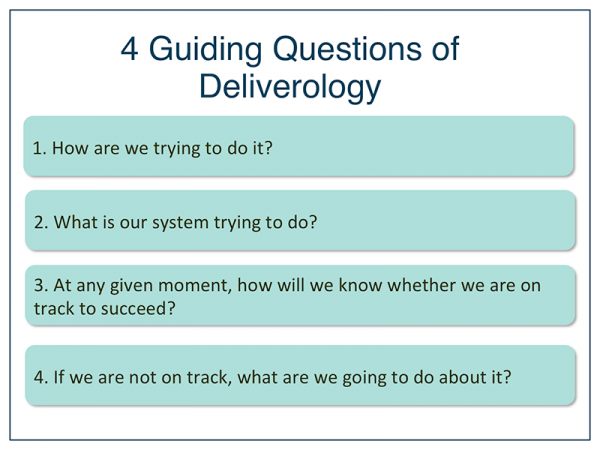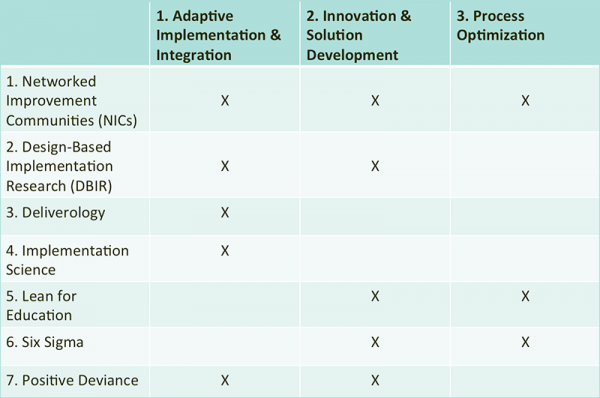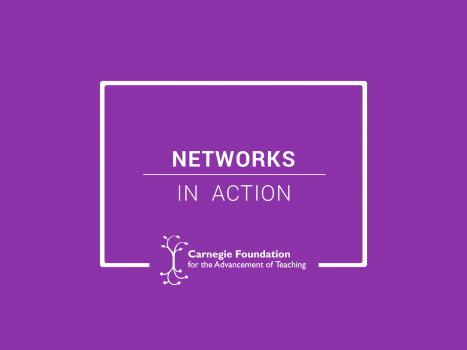Editor’s note: The current issue of Quality Assurance in Education is a special one, devoted entirely to exploring seven different improvement-based approaches to change being used in schools. Over several weeks, the Carnegie Foundation will publish blog posts summarizing each of the models, including the process, examples, and pros and cons. “Networked Improvement Communities: Deliverology,” is written by Paul G. LeMahieu of the Carnegie Foundation, Lee E. Nordstrum of RTI International, and Karen Dodd with the Kentucky Department of Education. We hope that these summary blog posts will whet your appetite to delve more deeply into the journal itself.
Deliverology is a quality improvement method designed to help organizations reach their goals by building upon the approaches they’re currently using, rather than starting over from scratch. It does add a key dimension, however, by having organizations carve out time to reflect on their improvement work, effectively and consistently implementing strategies for improvement. “Deliverology tries to honor what organizations are already doing, while providing a common and predictable structure, consistency and rigor for their work,” write the authors.
The method was first developed in 2001, by the U.K. government under Tony Blair. It was used to establish the Prime Minister’s Delivery Unit (PMDU) to create routines and problem-solving techniques that would help the administration deliver on its campaign promise to increase the effectiveness of public services. In 2010, deliverology spread to the field of education with the creation of the U.S. Education Delivery Institute (EDI), which helped educational leaders (often at the state level, as in Alabama, Michigan, New York, and Texas, to name a few) implement their priority strategies for reaching ambitious student outcome goals.
Fundamentals of the Model
Deliverology is guided by four key questions (which are similar to those in the networked improvement model that we wrote about last week), designed as prompts for organizations to specify their goals and map out a route to meet them.

There are five components of the method itself: 1) develop a foundation for delivery, 2) understand the delivery challenge, 3) plan for delivery, 4) drive delivery, and 5) create an irreversible delivery culture.
The five components are further refined by 15 elements that fall under them. For example, under component three, plan for delivery, organizations need to determine their reform strategy, set targets and trajectories, and produce delivery plans.
Any and all of these may be flexibly adapted and applied given a particular organization’s context and needs. This model, therefore, allows organizations to use other improvement approaches within the deliverology framework. An example from Kentucky shows how this works in practice.
Deliverology in Action-What’s the Problem?
The Kentucky Department of Education created the Commissioner’s Delivery Unit (CDU), the entity responsible for carrying out the improvement model. The CDU, like all delivery units in this approach, is a small group of organizational staff whose full-time job is to develop an action plan for each of the components of deliverology that, together, form a strategy for meeting the state’s education goals. These include such activities as data-driven decision making to set improvement targets. It should be noted that delivery units are meant to remain independent from the management of the individuals or groups they’re supporting through this work.
Deliverology is target-oriented; problems are identified and addressed in relation to how they impact the goals of the organization. Deliverology requires the organization to already have an agreed-upon objective or objectives.
Kentucky, like many states, faced problems. In 2013, according to the Kentucky Department of Education, just 34 percent of the state’s high school students were deemed college and career ready, and nearly a quarter of all high school freshmen didn’t persist to graduation. The department set a goal of doubling the college and career readiness rate and raising the graduation rate to 90 percent within two years. In addition, the state legislature passed a bill calling on the department to cut in half the number of high school graduates placed in college remedial classes and to increase college completion rates for those students by three percent a year.
With the goals in place, deliverology provides the framework to identify target metrics and leading indicators to get a picture of how the system is operating and to understand the root causes, or drivers, of the patterns they see in the data. The delivery unit identifies current activities in the system that attempt to influence those underlying drivers and then maps these existing strategies in a “delivery chain” that shows all the people and processes involved in a given activity. The delivery chain can then reveal potential problem areas to be addressed.

Deliverology in Action-Finding Solutions and Assessing Improvements
Deliverology essentially assumes that the big-picture solutions to a problem are already known; in this respect, this model values building upon what organizations are already doing well. It focuses instead on solving the problems that arise when implementing these known solutions.
For example, the Commissioner’s Delivery Unit in Kentucky knew that one way of meeting its goal of increasing college and career readiness was to provide opportunities for high school students to earn certifications or college credits. The CDU did not use deliverology to identify this potential solution; instead, it used the model to research the system’s current effectiveness in implementing the strategy by tracking student participation and performance in dual enrollment programs.
Delivery units are meant to support an organization’s leaders in developing a theory of action (how to get from current outcomes to desired outcomes), identifying strategies to reach the stated goals, and sequencing these strategies in the form of a delivery plan (see the CDU’s Delivery Plans). These plans are essentially implementation guides, but, importantly, are intended to be iterative; that is, they are tested, challenged, and revised over time.
Delivery units set up routines and procedures that provide structured opportunities to review and reflect on outcomes, address emerging issues, and share best practices between individuals and groups. In Kentucky, stakeholders meet regularly to discuss data, arrive at a shared view of progress, and collectively decide how to keep the work on track.
The deliverology approach spreads knowledge and change ideas by establishing a delivery culture, which requires widespread buy-in. This means the delivery unit must put structures and resources in place and ensure that everyone in the organization has the necessary training to implement the delivery plan.
Understandably, communication and positive working relationships are both very important in deliverology. The improvement message must be effectively and consistently communicated to all stakeholders, and the delivery unit itself must be accessible and transparent in order to build and maintain trust and goodwill.
Sarah McKay is a former associate for research and communications at the Carnegie Foundation.
February 23, 2017
A special issue of the journal Quality Assurance in Education breaks down seven approaches to improvement in education, beginning with the networked improvement model. Explore key features and principles of this method through a successful example of helping new teachers.
March 3, 2017
Social relationships are key to the potential of networked improvement communities to accelerate and sharpen education change using the improvement science approach. Veterans of the process explain how they keep strengthening those connections while expanding their networks.







